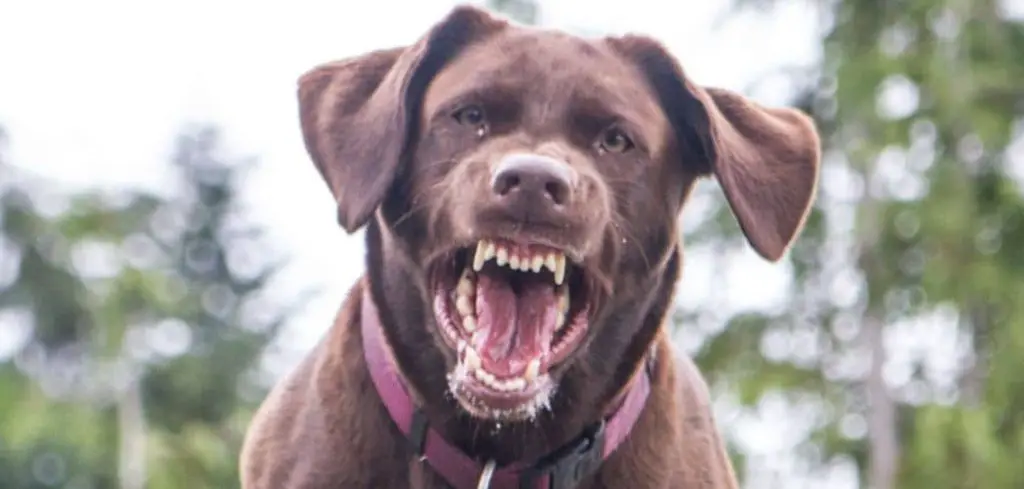Seeing your senior dog act aggressively can be alarming and concerning, especially if this behavior is new or worsening.
Aggression in older dogs may indicate pain or underlying medical issues that require attention.
We outline the common reasons for an old dog getting aggressive, what you can do at home, and when to seek veterinary help.
Old Dog Getting Aggressive — Why It Happens
An old dog becoming aggressive often happens because aging can bring physical discomfort, illness, or reduced senses like hearing and vision, which make the dog feel more vulnerable or easily startled. Pain from conditions such as arthritis or dental disease can lower their tolerance for handling, while cognitive decline may cause confusion or anxiety that leads to irritability.
Changes in routine, environment, or the introduction of new pets can also trigger defensive behavior.

Old Dog Getting Aggressive: Common Causes
Pain or Discomfort
Chronic pain from arthritis, hip dysplasia, dental disease, or internal injuries often leads to aggression.
A dog experiencing pain may growl, snap, or avoid touch when approached. They may also show signs of stiffness, reluctance to move, or decreased activity.
Addressing pain through veterinary treatment or pain management strategies is crucial to reduce aggression and improve quality of life.
Read more: Old Dog Face Twitching (Here’s why)
Cognitive Dysfunction Syndrome
Cognitive dysfunction syndrome (CDS), similar to dementia in humans, affects many senior dogs.
Symptoms include confusion, disorientation, altered sleep patterns, and increased irritability or aggression.
Dogs may react aggressively when touched or approached, especially if they feel threatened or confused. Early recognition and management of CDS can help minimize stress and aggressive outbursts.
Sensory Decline
Hearing and vision loss can make older dogs more reactive to sudden movements or noises.
Dogs with sensory decline may startle easily or misinterpret routine interactions as threats, leading to aggressive responses.
Creating a safe, predictable environment and using gentle communication can help reduce these reactions.
Anxiety or Fear
Anxiety in senior dogs can be triggered by changes in routine, new family members, or stressful environments.
Aggression often manifests as growling, snapping, or lunging. Identifying stressors and implementing calming strategies, such as consistent routines, environmental enrichment, or pheromone therapy, can help manage fear-related aggression.
Medical Conditions
Underlying illnesses like thyroid imbalances, brain tumors, infections, or kidney disease may contribute to irritability and aggression.
Changes in behavior may accompany other signs like appetite loss, vomiting, lethargy, or increased thirst.
Veterinary evaluation is essential to diagnose and treat medical issues that could be causing sudden aggression.
Resource Guarding
Older dogs may develop heightened sensitivity over food, toys, or sleeping areas.
They may growl or snap if they perceive a threat to their resources. Understanding triggers and modifying interactions through training or environmental adjustments can reduce aggressive incidents.
What to Do If Your Old Dog Is Getting Aggressive
Monitor your dog’s behavior closely to identify triggers, frequency, and intensity of aggression.
Provide pain management and veterinary care if medical issues are suspected, including arthritis treatment, dental care, or medications.
Maintain a calm and structured environment, minimizing sudden changes and providing safe spaces where your dog can retreat.
Use positive reinforcement to reward calm behavior and avoid punishment, which can escalate aggression.
Consider professional guidance from a veterinary behaviorist for ongoing management, particularly if aggression puts household members or other pets at risk.
When to Call or Visit Your Vet
Immediate veterinary attention is warranted if your old dog:
- Shows sudden or escalating aggression without a clear trigger.
- Exhibits other signs of illness, such as vomiting, diarrhea, lethargy, or sudden weight loss.
- Has difficulty moving, appears in pain, or has neurological symptoms like disorientation or seizures.
- Poses a risk to family members, children, or other pets through unprovoked biting or snapping.
Prompt evaluation helps identify underlying causes, whether medical or behavioral, and ensures proper management for safety and comfort.
Read more: Old Dog Grinding Teeth and Drooling (Here’s why)
Key Takeaway
Aggression in an old dog can be caused by pain, cognitive decline, sensory loss, anxiety, or medical conditions.
Observing behavior, providing veterinary care, maintaining a calm environment, and seeking professional behavior guidance are essential steps to ensure your dog’s safety and wellbeing.
Addressing the root causes promptly can prevent escalation, reduce stress for both you and your dog, and help your senior dog enjoy a more comfortable and secure life.
